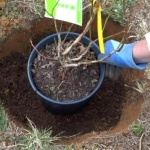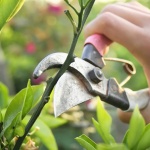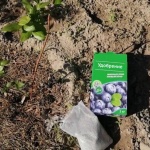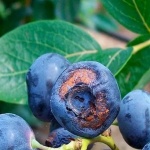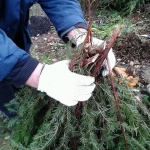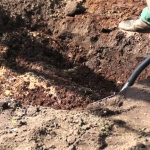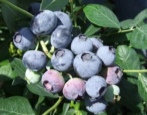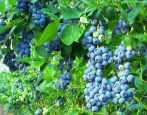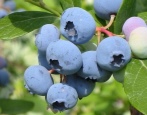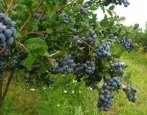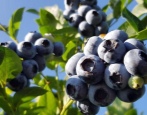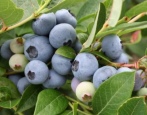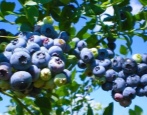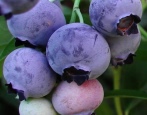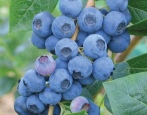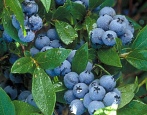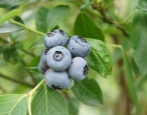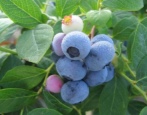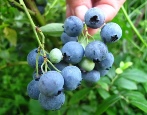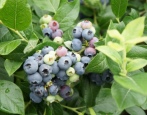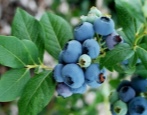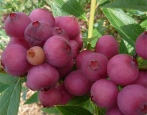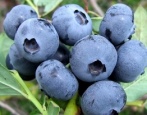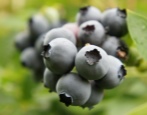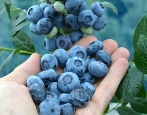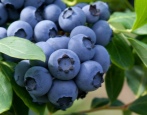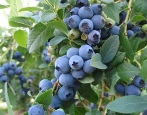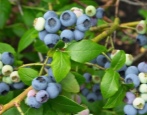
- Name synonyms: Vaccinium corymbosum Herbert
- Ripening terms: late ripening
- Growth type: tall
- Bush height, m: more than 2
- Taste: sweet, delicate, practically without acidity
- Yield: high
- Average yield: up to 9 kg per bush
- Fruit size: large
- Fruit shape: flattened
- Fruit color: blue
The Herbert blueberry variety is also known by the names Herbert, Herbert and the more complete Vaccinium corymbosum Herbert. A variety of this berry crop is characterized by high yields and the ability to withstand low temperatures.
Description of the variety
Herbert grows into a tall and wide branching bush, the height of which ranges from 150 to 200 centimeters or more. Flowering occurs from May to June and is accompanied by the blooming of delicate pink flowers. Blueberry buds look like lily of the valley flowers. Glossy leaf blades with the arrival of autumn change from a rich green color to bright red. They have a rounded, slightly elongated shape and medium size. The flexible shoots often tend to the ground under the weight of the berries. Their smooth reddish bark becomes rough and dark over time. By the end of the season, the branches may generally turn dark gray.
Fruit characteristics
Herbert blueberry fruits reach a diameter of 20-25 millimeters, and their weight varies from 2 to 2.5 g. Round, slightly flattened berries of regular shape have a dark blue color. The surface of dense berries with a medium scar is covered with a waxy coating.
Taste qualities
The juicy pulp of Herbert blueberries has a sweet, not sugary taste without the slightest hints of acidity, which makes it an ideal product both for processing and freezing, and for fresh consumption. The aroma of the fruit is bright and pleasant.
Ripening and fruiting
Fruit ripening in the Herbert variety begins by mid-August, which makes it possible to classify this variety as late-ripening. In cold climates, harvesting begins in late summer. Despite the fact that the berries ripen at the same time, the bush bears fruit for 2-3 weeks. Even after full ripening, they do not crumble from the bush, and the skin retains its integrity.
Yield
Herbert is considered a high-yielding variety: from each bush per season, the gardener manages to collect an average of 5-9 kilograms of berries. Blueberries tolerate transportation well, and also have a good keeping quality: by maintaining the temperature from 0 to +3 degrees Celsius, they can be saved for 2 months. In a refrigerator compartment, blueberries are usually stored for about a week.
Self-fertility and the need for pollinators
Some gardeners believe that Herbert is able to bear fruit even when there are no pollinating bushes nearby. However, a number of specialists prefer to have a number of representatives of other varieties to improve yields. Jersey and Chandler are usually the pollinators for Herbert.
Growing and care
Herbert prefers acidic soil with a pH of 4.5 to 5.5 and good air permeability. The drainage layer is no less important for the culture, and it feels best on a mixture of peat and sand or peat and loam. The largest and sweetest berries grow in blueberries in areas that are well lit and protected from northern winds. This variety is able to withstand winter cold snaps, up to -32 ... 35. Bushes do not even need additional shelter at this time.However, Herbert cannot be called an unpretentious plant - moderate but regular watering is extremely important for this blueberry. If there is not enough moisture, then the yield of the crop will fall, and excessive watering leads to the occurrence of fungal diseases.
It is recommended to plant Herbert in the autumn, as this will allow the plant to acquire stronger immunity. However, it is possible to carry out the procedure in the spring. The greatest likelihood that the planting will be successful arises in the case of using two-year and three-year-old seedlings. A blueberry plot can be prepared a month before planting. In a suitable area, soil is necessarily dug up, and excessive oxidation is normalized by adding wood ash or dolomite flour. If the soil has neutral acidity, then, on the contrary, it will require the addition of peat or needles.
A hole is dug 40-50 centimeters deep. The length and width of the recess are kept approximately the same. It is important that a gap of 1-1.5 meters is maintained between the individual holes. Having filled the pits with a mixture of peat and sawdust, you will need to leave them to sit down. Immediately before planting, the roots of blueberry seedlings are soaked for about 30-40 minutes. The specimens are carefully immersed in the holes, their roots are straightened, and everything is covered with soil. It is necessary to make sure that the root collar is deeper by 4-5 centimeters. After filling the soil, abundant irrigation and mulching of the near-trunk zone is carried out.
Blueberries Herbert will require regular watering as the topsoil dries out. In dry periods, the procedure is allowed to be carried out 2-3 times a week, directing about 10 liters of liquid under each bush. Fertilizing crops are carried out from the second year of cultivation.
